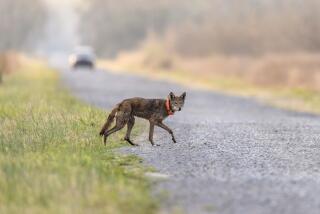Hunter’s Trophy Heightens Debate Over Possibility of Wolves in Maine : Wildlife: The marksman faces jail time and a fine if his hunch is right. But while tests are run, a debate over the endangered animal burns.
- Share via
AUGUSTA, Me. — She looked like a wolf, from head to bushy tail. And if the canine killed by a Pennsylvania man turns out to be a wolf, the hunter may face trouble, since the animals are an endangered species.
But more curious to wildlife experts is the possible presence of a wolf in Maine at all. Wolves in any number haven’t roamed in this corner of the United States--or most of the Lower 48--for a century at least.
The mystery of the maybe-wolf began Aug. 26, when two Maine game department employees reported seeing a wolf-like animal in St. John Township, an isolated wilderness in northwestern Maine about 25 miles east of the Canadian border.
Five days later and just three miles away, a bear hunter shot what he thought was a wolf.
The hunter brought his prize to the nearest warden station, apparently unaware he may have broken federal and state law, officials said.
“He said it was a wolf, it looked like a trophy wolf, and he wanted it,” said the warden, Sgt. Daniel Tourtelotte. Any charges and disclosure of the man’s name depend on what scientists discover.
The head was sent for tissue testing at the U.S. Fish and Wildlife Service forensics laboratory in Ashland, Ore. The outcome may not be known for months. In the meantime, it could only heighten debate over whether the wolf is back in Maine.
The Fish and Wildlife Service, trying to reintroduce the wolf to Yellowstone National Park, has proposed bringing timber wolves back to some Eastern states.
Maine officials oppose this, saying Maine has enough trouble with coyotes. Natural wandering is something else, though. Said George Matula, a state Inland Fisheries and Wildlife biologist: “The department is certainly not against the wolves coming in on their own.”
Opposition outside state government comes largely from hunters’ groups worried about wolves attacking game animals.
For all the controversy attached to wolves, their numbers are few. The federal government lists the animals as endangered in all the Lower 48 states except Minnesota, where an estimated 1,800 wolves live and the animal is listed as “threatened.”
The only other states with sizable wolf packs are Wisconsin and Michigan, with 60 between them, said L. David Mech, a Fish and Wildlife biologist.
Wolves once ranged over much of the United States. They disappeared along with the bison they preyed on and the forests they lived in. People also killed wolves as pests.
Now, anyone who kills a wolf risks a $100,000 federal fine and a year in jail. Maine law exacts a $500 fine and six months in jail for killing wolves.
So the question comes back to the mystery animal.
Is it a dog or a wolf? Or a bit of both?
Matula, who examined the creature, said it weighed 67 pounds, was 5 feet, 8 inches long, and 2 or 3 years old.
The coat was charcoal-colored with a whitish underside. Its head was larger than a dog’s, its bottle-brush tail was straighter and its legs longer.
“We knew it wasn’t a coyote,” said Matula, who examined the creature and found no obvious signs that it was domesticated, such as clipped nails or worn paw pads.
So what if it turns out to be a wolf? And how did it get here?
“It’s a bit of a complexity,” said Daniel J. Harrison, an associate professor of wildlife at the University of Maine. “It’s not at all out of the question (that wolves) could be here.”
Theories abound.
The animal might be a wolf raised in captivity that somehow got out. It may have come from Canada.
Wolves inhabit the Laurentian Highlands of Quebec, Canada, about 100 miles northwest of Maine. Wolves are also known to travel up to 500 miles from their native areas, said Harrison, an expert on the wild dog family.
For now, the wolf issue will likely be more a matter of science and speculation.
Even if wolves are returning to Maine, it could be decades before any noticeable population appears, Harrison said.
More to Read
Sign up for Essential California
The most important California stories and recommendations in your inbox every morning.
You may occasionally receive promotional content from the Los Angeles Times.













